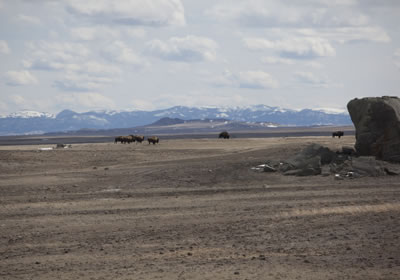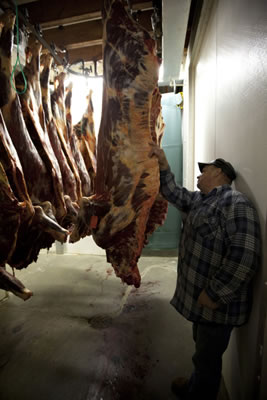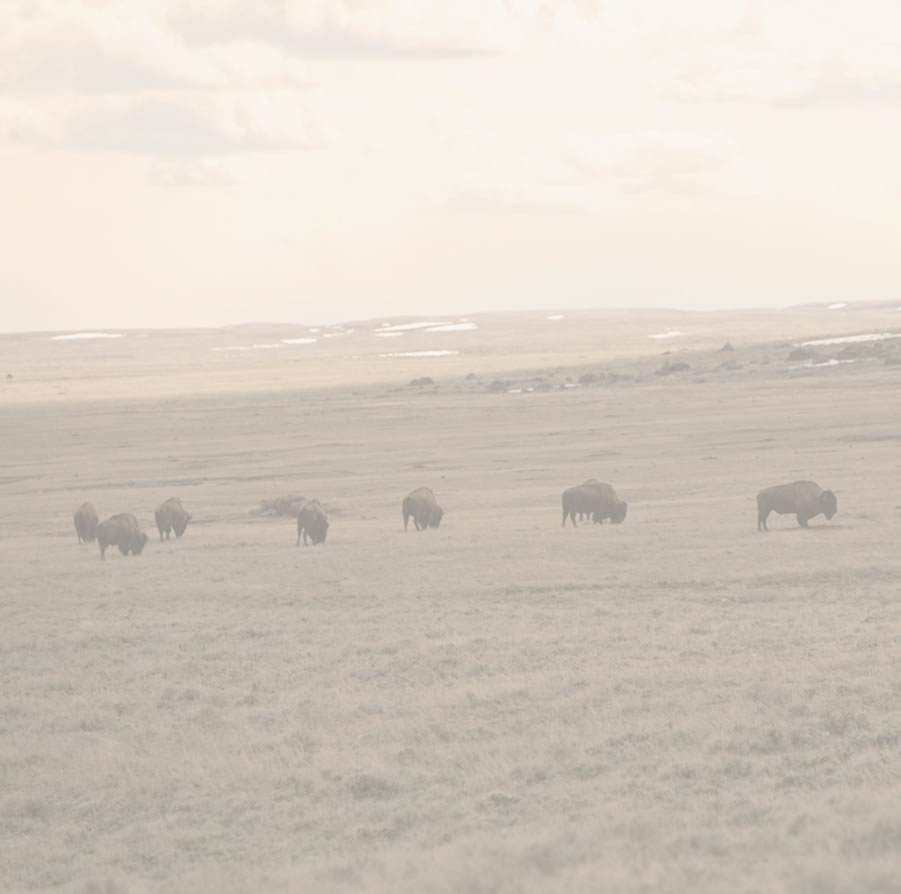Vital resource
By Victoria Edwards
Photos & Multimedia by Cole Margen
Jerry Green is used to having blood on his hands, but today there's nothing to slaughter.
The cold metal cutting tables of the Little Rockies Meat Packing Co. in Malta, Mont., are sterile and vacant, and the holding pens outside are empty after yesterday's slaughter of six buffalo. Their carcasses are suspended from the ceiling on this March afternoon, but buffalo rarely hang here anymore.
The plant, owned by the Fort Belknap Reservation Assiniboine and Gros Ventre tribes, has shifted its focus from processing buffalo from the tribe's herd. Now it primarily survives on business from cattle ranchers around Malta, which is located more than 40 miles from Fort Belknap.
"I wouldn't mind seeing 400 or 500 buffalo go through here, but right now all we're doing is cattle for the local ranchers," Green says.

Bison graze on Fort Belknap Reservation lands near the Little Rocky Mountains. The Gros Ventre and Assiniboine tribes keep more than 400 animals on the reservation.
The six buffalo slaughtered at the plant came from the Fort Peck Reservation's buffalo herd more than 100 miles east of Malta, and account for half of the buffalo slaughtered at the plant this year.
Green has run the plant since 2008, and says business has picked up and gone down repeatedly in the past few years. Slow days like today aren't uncommon in the history of the plant.
In 2009, Green says, the plant slaughtered 167 buffalo, but that number dropped to six in 2010.
The sporadic demand has resulted in only enough money to cover the plant's operating costs and payroll. It also hasn't progressed toward the goal of becoming a place of vast employment for tribal members. Green isn't Native American, although his four employees are tribal members.
"If we can pick up and do more beef and more buffalo there will be more people coming in and I'll have job openings for them," he says. "But at the present time there is none."

A tag adorns a freshly slaughtered bison at the Little Rockies Meat Packing Co. in Malta.
The meat packing plant was established in 2002 by the Fort Belknap tribal government, and is the first tribally owned, U.S. Department of Agriculture-certified meat packing plant in the country.
The Little River Smokehouse in Fort Belknap Agency on the reservation was started in 2006 to sell buffalo products processed at the plant. However, the smokehouse has yet to turn a profit and shut down temporarily in March because operators weren't able to fill orders for its products or cover operating costs.
Both struggling ventures represent the difficulty Fort Belknap has faced in breaking into the growing market for buffalo meat, and restoring the bison as a natural resource on the reservation.
Today more than 400 bison graze the 22,000-acre pasture that lies in the shadow of Snake Butte, a prominent tabletop rock formation that rises out of the prairie. Set against the endless and uninterrupted horizon of northcentral Montana, they look much like they did thousands of years ago, before westward expansion and the American government's open encouragement of the buffalo's extermination in the late 1800s.
Despite decreasing from an estimated population of 60 million to fewer than 1,000 in a matter of decades, for more than 30 years bison have been making a comeback on Fort Belknap.
Originally brought back in 1974 for their cultural importance to the reservation's tribes, the buffalo have since become an economic tool for the reservation.

The skull of a bison sits at the Little Rockies Meat Packing Co. The tribe sometimes uses the skulls and hides of slaughtered bison for religious or artistic purposes.
Despite the idle state of the meat packing plant and smokehouse, the herd has evolved to become more than just a tie to the past; it is now moving toward becoming the future of the reservation's economy.
The Fish and Wildlife Department on Fort Belknap, which manages the buffalo, makes more money than almost any other department on the reservation, bringing in around $100,000 to $150,000 a year, says Mike Fox, a tribal council member who has managed the herd on and off for the past 20 years.
In January the tribes made $60,000 from selling 57 of their buffalo. The money is funneled into a general fund, and goes to support not only the Fish and Wildlife Department, but other agencies and programs on the reservation as well, he says.
Revenue from the bison has so far come solely from selling the animals, but now managers are looking to stop selling and start fully utilizing the meat packing plant and smokehouse. High demand for buffalo meat outside the reservation and more populated areas is the driving force in Fort Belknap's attempt to make their herd more profitable.
The National Bison Association reports that the price of the carcass of a young bull in 2010 was 58 percent higher than the price three years earlier.
"I've been saying this for the past three years, we've had the three components — the buffalo herd, the packing plant, and the smokehouse — but we haven't been able to connect the dots," Fox says. "We're finally moving in that direction this year."
Island Mountain Development Group, a company that works in developing businesses on the Fort Belknap Reservation, took over both the meat packing plant and smokehouse in January, bringing to the table a new business plan and management team that is working to turn the businesses around to make them profitable.

A summer sausage sits in a cooler at the smokehouse on the Fort Belknap Reservation. The smokehouse was recently closed due to lack of funding.
As the chief executive officer of the organization, which employs 20 people on the reservation, Michelle Fox, Mike Fox's niece, knows what it takes to succeed in business. She graduated from Dartmouth in 1998 with a business and marketing degree. She doesn't falter in making tough decisions.
In December Michelle Fox opened the Smokehouse Grill in Fort Belknap Agency without using any tribal funds. With a $70,000 grant from Indian Country Economic Development Program, which is overseen by the Montana Department of Commerce, she was able to start the restaurant. A month later she opened a second business across the street in the Fort Belknap Casino, called the Smokehouse Deli.
Both locations will be a tool for Michelle Fox to promote the products that come out of the Little Rockies Meat Packing Co. and the Little River Smokehouse.
While the restaurants and smokehouse provide a service to the community by offering a place to dine out for those who have few other options, she's also hoping to attract tourist traffic and begin to sell the plant and smokehouse products nationally.
"It's important the resource is here for our people, but if we're going to make any money, it's definitely going to be targeting other outside individuals," she says.
She's hoping to acquire a contract with Sysco, the largest food distribution company in the country, as well the company that provides food to the U.S. National Park Service. But with the smokehouse's temporary closure and the restaurants' need for a reliable source of meat, Michelle Fox is branching out from selling mostly buffalo, and moving into beef.
She currently has 15 cows on a feeding program in hopes that the Little River Smokehouse will reopen by May with a beef product that's been grain fed for 45 days.
But that will take money, a factor that isn't unfamiliar. "It always takes money," she says.
She's asking the Fort Belknap Investment Board for $250,000 to fund four different projects, which include the plant and the smokehouse. The money would go toward a grazing and feeding facility or pasture that would house buffalo and cattle for 30 to 45 days. They would then be taken to the plant for slaughter, and the finished products would be sold in the smokehouse, restaurants, and, she hopes, on a national scale.
With the success of the smokehouse and the meat packing plant not yet assured, Michelle Fox says it's difficult to tell when they may be profitable.
"I hope that in six months it will cash flow, but to actually make money…I mean it could be two years, it could be five years," she says.
But money woes in the business of buffalo haven't been the only dilemma facing the tribes in developing the bison as a natural resource.
In winter, wind that can reach hurricane force sweeps the snow across the pasture and begins to pack against its fences, forming dense bridges of snowdrifts along the reservation's western border. The result is an easy escape route for the buffalo to leave their pasture and go onto neighboring land.

Jerry Green, manager of the Little Rockies Meat Packing Co., inspects the carcass of a freshly killed bison. The facility is the only USDA-certified, tribally owned plant in the country.
Just as the snow rises over the fences, tension also begins to build between the tribes and landowners bordering the reservation.
Walter Funk's property abuts five miles of the western border of the buffalo pasture. He says the buffalo have trespassed onto his land for years, but says it wasn't until 2009 that he got the tribes' attention on the matter.
"The buffalo had been trespassing for years and years, and we had went over and complained to the council and nothing ever happened," he says.
By late February 2009, Funk says the buffalo had crossed over the snow and onto his land multiple times. Frustrated and fed up with the ongoing problem, he took action when the animals crossed over for a third time in three days. Returning to the area with a rifle in tow, Funk saw the solution.
"I thought, well, it'll get your attention, so I shot four of their buffalo, and I really got their attention," Funk says in a calm and matter-of-fact tone.
Funk says his concern with the buffalo trespassing on his land always boils down to one thing — the Conservation Reserve Program.
The program works to convert highly erodible land to vegetative cover like grass in order to allow soils to regenerate and to improve water quality and increase wildlife populations. The federal government annually pays farmers and ranchers who enroll their land in the program.

Wesley KillEagle, an employee at the Little Rockies Meat Packing Co., stands among a pile of bison hides and skulls.
Because CRP land is highly erodible, no animals can graze or even be present on the land.
A few years before he shot the four buffalo, Funk says he was fined more than $5,000 and his CRP payment was suspended when they crossed over the snow-buried fence and onto his land.
The federal government eventually waived the fine, "but it took over a year to get my money," Funk says, referring to the annual CRP payment he receives.
Fort Belknap wasn't reimbursed for the buffalo Funk shot, and Mike Fox says the council argued to get Funk's fines waived.
Although Fox agrees their management plan needs to change to prevent the herd from escaping, a consistent stream of misunderstanding and miscommunication between neighbors continues to fuel the tension year after year.
"Why raise them? They've been nothing but trouble," Funk says, unaware the herd is one of the biggest money-making tools for the reservation, in addition to being of cultural importance to the tribes.
Funk also says he doesn't believe the herd is fed properly through the winter months and that's the reason they wander onto neighboring land.
"When they get hungry, they go where there's something to eat; they're no different than any other living creature," he says.
To Fox, the idea is laughable, and he shakes his head as a grin appears on his face when he hears it.
"We have the acreage to prove that we have adequate grazing," he says. The herd is also fed hay for three months during the winter, but as wild animals, Fox says they will always prefer to graze on grass.
Fox recognizes the need for a change in management to bring an end to the ongoing escapes, and says the Fish and Wildlife Department will begin construction this summer on a holding pasture to keep the bison away from land neighboring the reservation.
Fox knows how to fix the problem, but doesn't have the funds to fully implement the solution.
The fence for the holding pasture will cost between $200,000 and $250,000, and the Fish and Wildlife Department doesn't have enough money to construct a full-scale holding pasture. Fox says they plan to construct a smaller pasture first and will expand it as money becomes available.

Sean Chandler, director of American Indian Studies at Fort Belknap College, stands outside one of his classrooms. Chandler and his wife, Lynette, founded the cultural immersion school.
"We're trying to be good neighbors, so we may not totally get that this year, but next year we'll just keep a closer eye on them if they're still in the main pasture," Fox says.
The winter holding pasture is an idea that satisfies Funk's call for better management, and staying in the good graces of their neighbors is key if Fort Belknap wants to proceed with their plan of acquiring some of Yellowstone's genetically pure bison.
Almost all bison, including those on Fort Belknap, are the offspring of bison experimentally crossbred with cattle. One of the last genetically pure herds lies in Yellowstone National Park, and in receiving some of those bison Fox says he hopes to preserve their exceptional genetics.
"If you don't establish satellite populations of them, some oddball disease may come in and wipe that whole population out, and they're gone forever," he says. But brucellosis, a disease that causes cattle and buffalo to abort their fetuses, has caused some Yellowstone buffalo to be quarantined. Fort Belknap is looking to obtain 80 bison from Yellowstone, which have been quarantined since 2005 and do not have the disease.
Brucellosis caused an uproar among ranchers who say the buffalo shouldn't be moved from Yellowstone for fear of cattle catching the disease. Four bills introduced in the Montana Legislature in its 2011 session would have placed regulations and restrictions on the Yellowstone buffalo's relocation. Two of those bills died, which will aid the Fort Belknap Reservation in moving toward getting some of the bison.
In mid-May Gov. Brian Schweitzer vetoed a bill that would have imposed a permit and inspection system for any bison transported between counties in Montana.
However, he signed a bill that gives the Department of Fish, Wildlife and Parks the authority to manage the bison and how they are transported, but would require a management plan before any bison are moved.
Behind a closed door in the back of the Little Rockies Meat Packing Co., Jerry Green keeps a sacred and integral piece of the tribes' culture.
Puddles of blood gather where the cement flooring dips. Near the red pools lie the skulls and hides of the buffalo slaughtered the day before. The flesh has been torn from the buffalos' heads and streaks of blood inhabit the cracks in the skulls. The hides are stacked and their hairless sides appear polished and fresh.
Green, the plant supervisor, sells the skulls and hides to tribal members, recognizing the bison's cultural importance. Depending on the size, he sells them for $40 to $100, saying he wants to keep them affordable.
Skulls are used in different ceremonies including sweats and sun dances, to keep tradition and spirituality alive. Hides are used for buffalo robes, drums and artwork, as a reminder of history and culture.

Al Chandler poses outside his cabin with a bison hide. Chandler is a traditional native artist on the Fort Belknap Reservation and he specializes in painting on hides.
And the herd on Fort Belknap is a testament of the perseverance of the Assiniboine and Gros Ventre tribes, says Sean Chandler, the director of American Indian Studies at Fort Belknap College.
The massacre of the buffalo brought the loss of the Plains Indians' life source. They no longer had meat to feed themselves, hide to clothe and shelter them, and bone to create tools from.
"I think you really see how important they were to us, because after that happened we became so dependent on everybody else except ourselves. We were no longer independent. We were no longer self-sustaining. We kind of had to hold our hand out," he says.
The buffalo are now a symbol of the Plains Indians' history.
"By them still existing today and being here on this reservation, there's that connection, it's a tie," Chandler says. "It's a direct connection to our past."
Despite politics and the tension between neighbors, the buffalo on Fort Belknap will graze the golden grasses of their pasture.
Despite new business plans for the meat packing plant and smokehouse, the buffalo will roam the prairie flanks of the snow-capped Little Rocky Mountains.
And the buffalo will continue to be an economic and cultural resource for the tribes, just as they have for thousands of years.
Cole Margen is a senior at The University of Montana School of Journalism.

